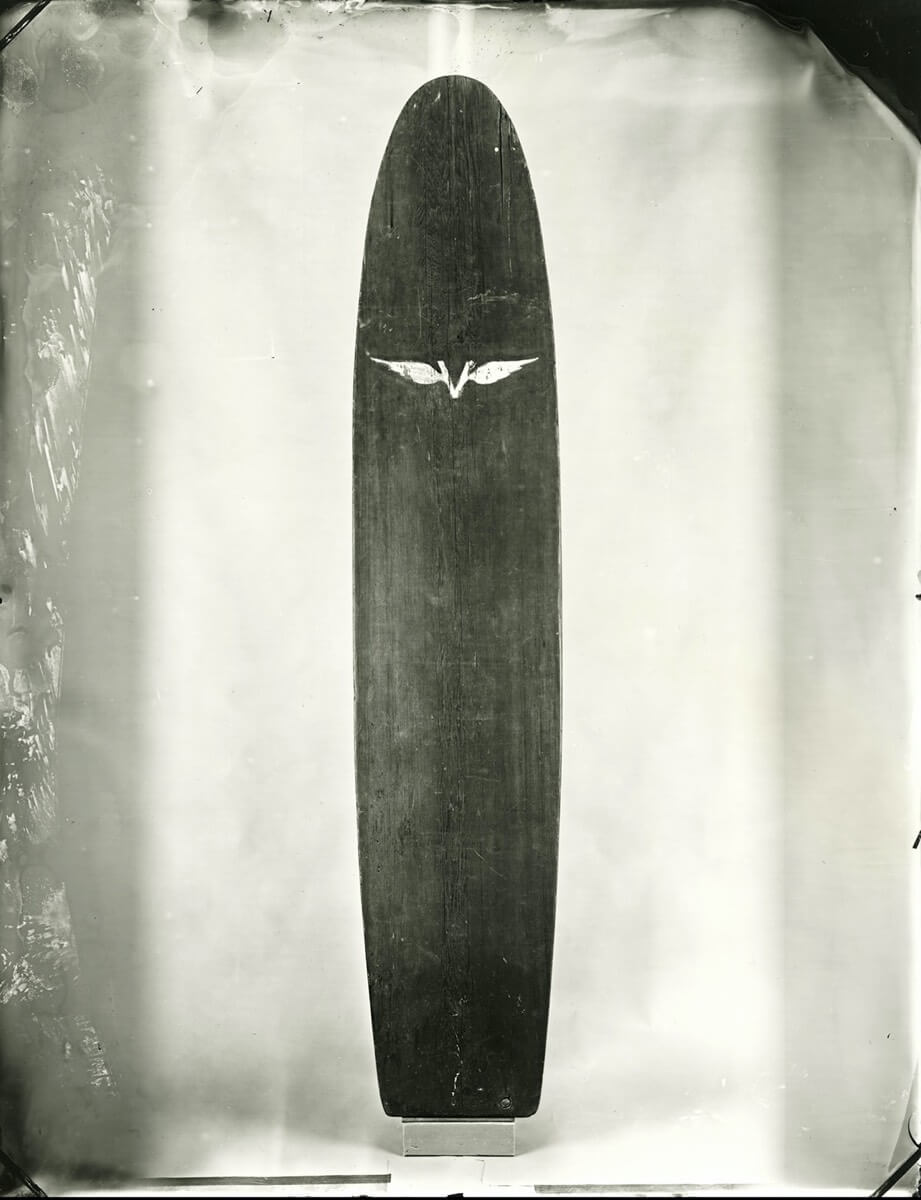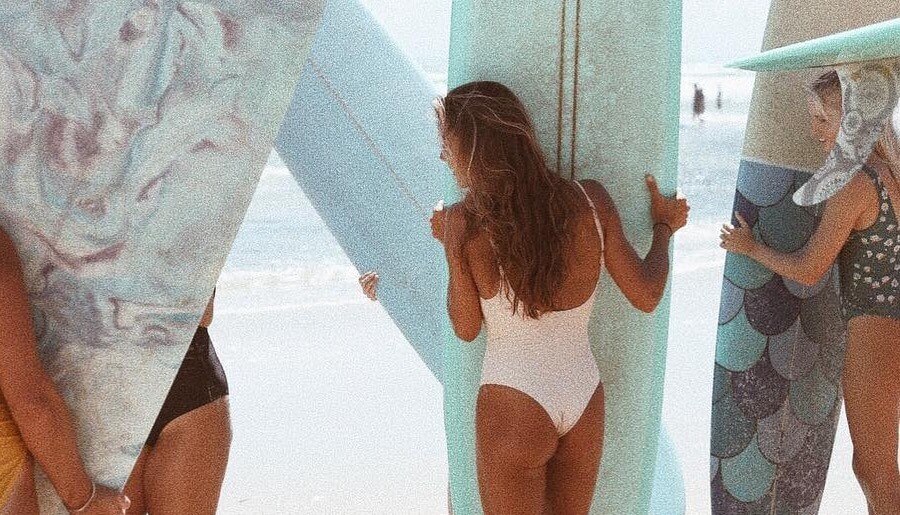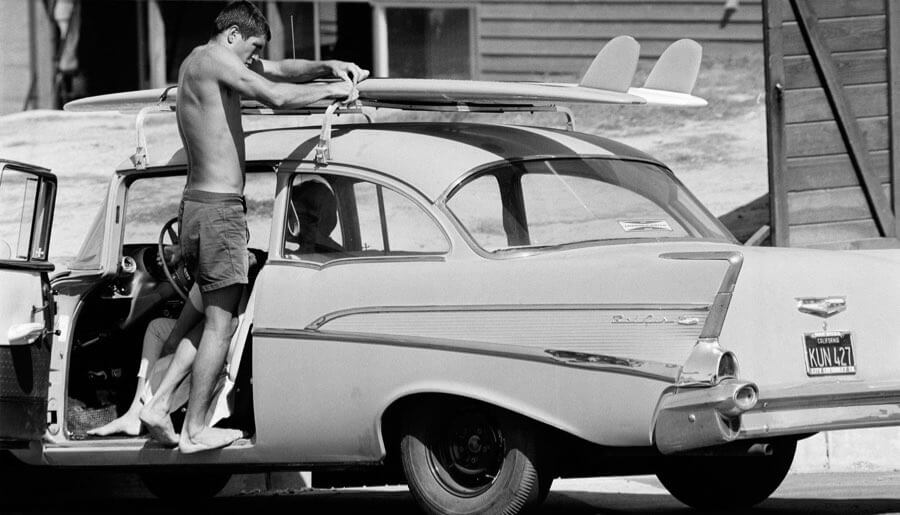The surfboards we ride today have come along way to be as good as they are. Many people have dedicated their lives to the pursuit of shaping and developing a better surfboard. Advances in surfboard design over the years range from size, weight, and shape, to fins and the materials used, to different boards designed for different waves.
Surfboard design has always been a very personal thing. Shapers tend to be surfers themselves, and surfboard design is as much an engineering feat as it is a love for surfing. Professional surfers work closely with shapers. Since each surfer rides waves differently — they know better than anyone how their surfboard needs to perform. The design process of a surfboard has always been a case of trial and error. A template is designed, then experimented with in the water, then feedback is considered and alterations are made accordingly.
Ancient Hawaiian surfboards
In the early days of surfing in ancient Hawaii. Surfing was a deeply spiritual affair, from the art of riding waves itself to praying for good surf, to rituals surrounding building a surfboard. Surfing was not only a recreational activity but also a training exercise for Hawaiian chiefs and a means of conflict resolution. There were two kinds of surfboard in these times, an ‘Olo’ (rode by the chiefs or the noblemen known as the Ali’i) and an ‘Alaia’ (rode by the commoners). The wooden boards were made using the Wili Wili, the Ula and the Koa trees. And ranged from 10 to 16 feet long depending on social class… 10-12 feet for commoners and 14-16 feet for the noblemen and chiefs.
Ron Croci created a beautiful series of illustrations to depict how the ancient Hawaiians created their surfboards. Take a look.

The decline and rise of surfing
In the late 18th century the arrival of Captain Cook to the Hawaiian Islands and later in the mid 19th century when the western/white missionaries arrived surfing almost died out in the islands. At the start of the 20th century, the missionary’s influence over the islands began to decline and Hawaiians along with the new European and American settlers began surfing again. One of these was George Freeth, who through his surfing, experimented with board design, and cut his 16 foot Hawaiian board in half. Making the typical solid redwood Hawaiian board of the time to around 6 to 10 foot long. George took his shorter board to California and became the first professional surfer, promoting a railway company in Los Angeles, California.
The hollow board
The next major change in surfboard design was in 1926 when one of the most famous names in surf history; Tom Blake designed the first hollow surfboard. The board was constructed of redwood, it had hundreds of holes drilled in it and was encased with a thin board of wood on top and below the board. The board was 15 foot long, 19″ wide, 4″ thick and weighed 100 lbs. This new design was at first ridiculed by local Hawaiian’s jokingly calling it the ‘Cigar Board’ until they saw how much faster it was in the water. Blake’s hollow surfboard became a great success and became the first mass-produced board in 1930. Blake also created the ‘fixed fin’ in 1935. This was a small fin attached to the bottom of the surfboard at the tail to allow surfers to manoeuvre better and give the boards more stability.
The Hot Curl board
The next major step in surfboard design came in 1934. Inspired by Tom Blake’s design, a group of surfers in Hawaii began experimenting with the tail size of the surfboard, shaving off parts of the tail and rail of the boards to get rid of the square tail. This gave the surfboard more manoeuvrability, allowing more radical surf manoeuvres. This group of surfers included Wally Froiseth, John Kelly, and Fran Heath. These new boards were called ‘Hot Curl’ boards, named because the boards allowed the surfer to manoeuvre into the ‘curl’ of the wave and ride in the barrel/tube.

Redwood, Balsa, and Plywood
In 1932 Balsa wood from South America became a popular material for building surfboards. The new balsa wood boards only weighed around 30 to 40 pounds as opposed to the 90 to 100-pound redwood boards. The boards had several coats of varnish applied to waterproof them. Such a reduction in weight was a major step forward in board design and became more and more in demand. The problem at that time was that balsa wood was hard to get hold of in large quantities, and so boards were constructed from both balsa and redwood, thanks to the recently contrived waterproof glue. Both kinds of wood have different properties, the balsa is light in weight and the redwood is tough/durable. And so the centre of the boards was constructed of balsa and the rails of the tougher redwood to strengthen the boards. Plywood was also later used around the time of World War One.
Fiberglass surfboards
The end of World War Two opened up new possibilities in surfboard design. Many new materials had become available through advances in technology during the war. Fibreglass was the most significant of these, also there was plastics and styrofoam. The first fibreglass board was built by a man named Pete Peterson in 1946, this surfboard was a hollow plastic mould, with a redwood stringer (a piece of wood running down the centre of the surfboard) and sealed with fibreglass tape.

Other pioneering modern surfboard shapers of this era were Joe Quigg and Matt Kivlin. Around this time a very significant man in surf history called Bob Simmons was building balsa wood surfboards and travelling up and down the Californian coast to surf and sell his boards. It wasn’t until 1949 when Simmons first fully made use of the fibreglass technology. His first attempt was a surfboard called the ‘sandwich’. This board had a styrofoam core, encased in a thin layer of plywood, with balsa wood rails and was coated in fibreglass.
Commercial surfboards
It was a man named Dale Velzy that took surfing a further step forward. Velzy was a well-liked character in California, a talented surfer, and a skilled shaper. He opened up his own surf shop and designed and built surfboards. He took all the shaping knowledge from innovators such as Joe Quigg, Matt Kivlin, and Bob Simmons and improved on it, creating the ‘pig board’ and later the ‘sausage board’. Velzy’s surfboards were in great demand, and so he took on a local surfer named Hap Jacobs (another big name in surf history) and taught him to shape. Balsa wood boards were still around for a while experimentations with foam continued. The development of polyurethane foam in surfboards came about in around the 1950s. Surfboards were still between 9 and 11 foot long in the ’50s.

Big wave surfing
In the mid to late 1950s, Hawaii had become very popular for its big waves. Many Californians rushed to the islands to surf these giant waves, including famous names like Greg Noll, Miki Dora, and George Downing (to name but a few). George Downing was one of the men responsible for developing the modern ‘Gun’ surfboard. It was named a ‘Gun’ as it is the surfers’ means of hunting down the big waves. The Gun was long and narrow making them easier to paddle out to the bigger waves and easier to control on the steep face of the wave.
Surfing in Australia
Australia had first been introduced to surfing in 1915 by the great Duke Kahanamoku. But it wasn’t until 1956 that modern surfing truly arrived down under. And it arrived in the form of a group of Californian surfers/lifeguards. The Californians brought with them the new Malibu boards made by Joe Quigg and Velzy/Jacobs. Local Aussies were stunned by the Californian’s manoeuvring abilities. The Californian presence had a big impact on the Australian surf scene, and many Aussies wanted the new fibreglass Malibu boards.
A few local Aussies bought some of the touring Californian surfboards and started to experiment with the boards, imitating their designs. Although at the time balsa wood was very hard to obtain, so the Aussies replaced much of the balsa in the boards with plywood. As production problems were overcome, the new surfboards became very popular and the new Malibu boards went into mass production. Through the coming years, the Aussies continued to further progress the design of the surfboard.

The shortboard, twin fins, and the surf leash
It wasn’t until the late ’60s to early ’70s that the shortboard came onto the surf scene. The average length of the surfboard went from 10 to 6 foot, with an obvious reduction in weight. These new boards allowed surfers to ride in the pocket of the wave and so were named the ‘pocket rocket’ board. Dick Brewer is credited with its design. These new boards allowed faster, more aggressive surf and more manoeuvrability. It was around this time that the twin fin was created, as opposed to just the one. Two fins gave the boards more stability in the water. Other changes were made to the board like alterations to the rail shapes, tails, bottom contour of the boards, the height of the rocker… anything to enable more speed and manoeuvrability.
Also in 1966, Nat Young (an Australian surfer) won the World Championships on a shortboard called ‘Sam’ designed by George Greenough and Bob McTavish. This board allowed greater performance style surfing with sharper turns and greater acceleration, which kick-started the ‘shortboard revolution’.
The shortboard design went through many experimental changes, one of which being different tail shapes to increase stability in the water and further enhance its manoeuvrability, this innovation was known as the ‘pintail’. A flexible fin system was also devised to allow surfers to add or remove as many fins as they saw fit, to tailor boards to their own style of surfing, this was also a great cost saver as new fins would not have to be glassed on every time they broke. And in 1971 the surf leash was created by one of Jack O’Neill‘s sons, Pat, much to the relief of frustrated surfers all over the world.

Three Fin Thrusters
Having three fins on a surfboard was an idea shapers had been experimenting with for years. But it wasn’t until 1981 when Australian surfer, Simon Anderson designed the three fin ‘Thruster’ surfboard that the idea caught on. The three fin design took the best features of the single and twin fin systems and made them work harmoniously together, giving the boards even more control in the pocket.
Popout and foam boards
The idea of a ‘popout’ board was that they had all the qualities of the modern shortboard, but they were manufactured more cheaply, and so more affordable. It was an Australian named Shane Steadman who came up with the idea in the 1970s. Later ‘foam boards’ were developed that were safer and easier to learn on.

To the future
From the ’80s onwards surfboards haven’t changed too fundamentally. Board artwork has become popular; the art of airbrushing and painting surfboards, one of the pioneers being surf artists, Drew Brophy and Eduardo Bolioli. Surfboards have become a lot thinner and lighter, allowing more radical surf and aerial manoeuvres. And in the mid-90s, the almost forgotten longboard came back onto the scene and is still a popular choice amongst surfers today, particularly with the learners and the older surfers.
Nowadays there are surfboards for every type of wave. The ‘gun’ is still popular for big surf, the ‘fish’ is a new variation of the shortboard, the cheaper and safer foamboards are used widely by surf school’s and of course, the Malibu or longboard and the shortboards will always be popular choices.
Curated by Andrew Couldwell on Apr 11, 2006

